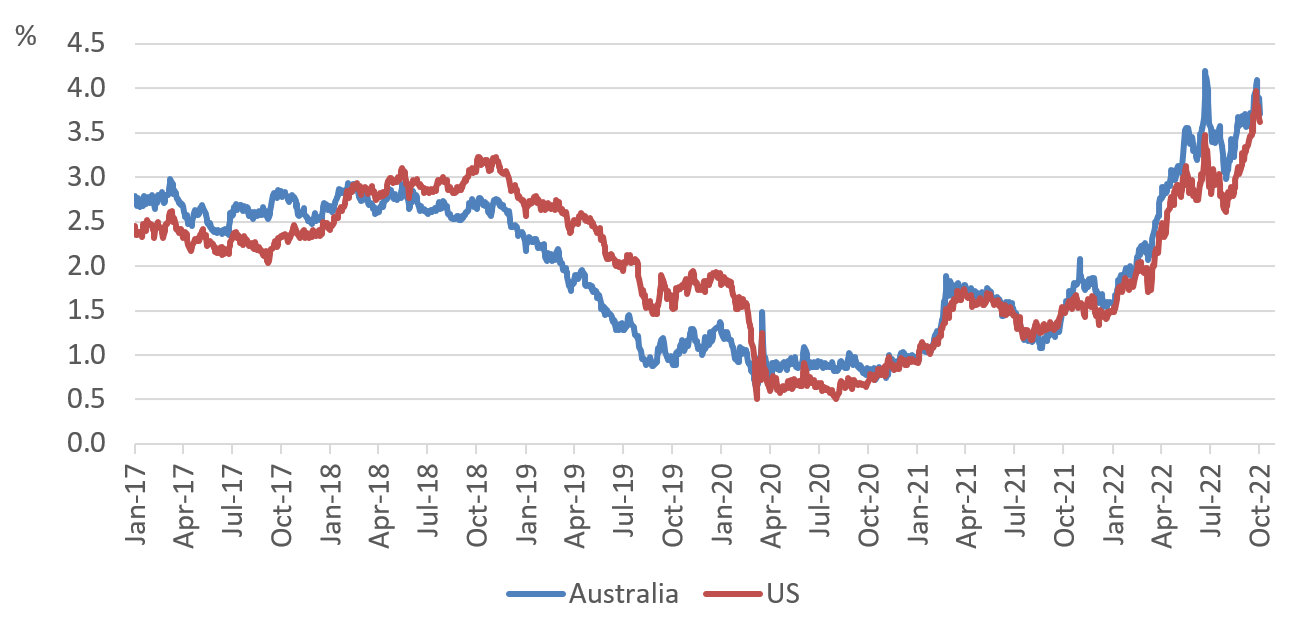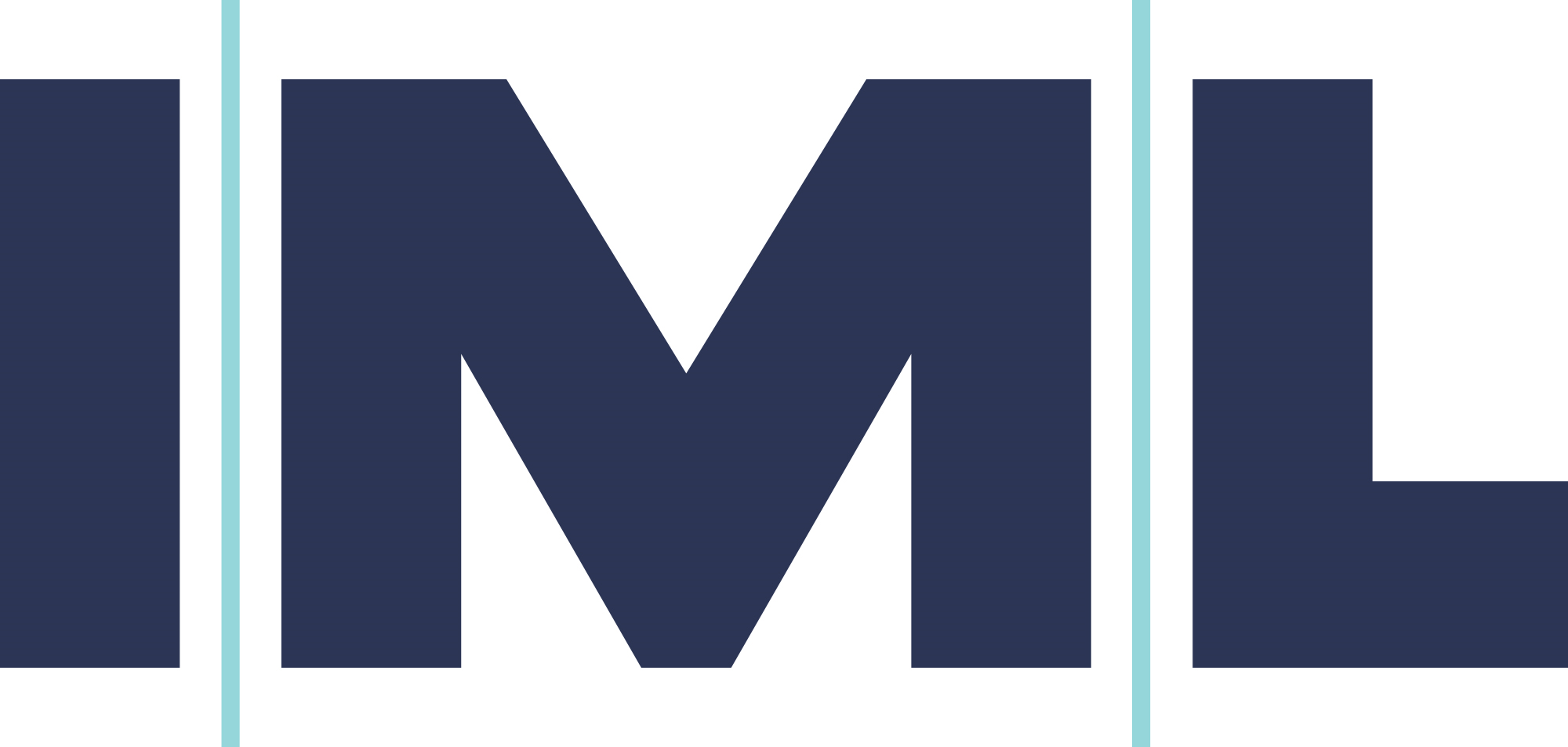Three reasons rising rates drive down share prices
During September we saw heavy falls in equity markets across the globe as many investors realised that Central Banks - led by the US Federal Reserve - would continue to raise interest rates for the foreseeable future until demand slows. The objective of slowing this demand is to take the pressure off the very high inflation rates that are currently being experienced in many parts of the world.
In addition to Central Banks pushing up short term rates, government bonds all over the world have also been weak since the beginning of 2022 as the higher inflation rate has spooked bond investors and led to much higher bond yields – see chart below.
Australian & US 10-year government bond yields

Source: FactSet, 4 October 2022
The level of ten-year government bond yields – which in economic theory are often referred to as the risk-free asset – are often used as a major component of the benchmark discount rate when determining the value of other assets. So, this rise in bond yields has had a negative impact, from a valuation point of view, on all asset prices including equities.
However apart from the impact that higher bond yields have had on valuations, how do rising short term interest rates directly impact company earnings?
We have identified 3 major impacts on company earnings from higher interest rates and inflation that investors need to be aware of:
#1: The higher level of interest rates set by the Central Banks directly increases the interest costs that companies must pay on their debt which directly impacts earnings.
This is a very important point as the more highly geared a company is, the greater the impact will be.
As part of our investment process, we analyse the balance sheets of current and prospective investments closely to determine the level of gearing of each company and the proportion of this debt which is fixed or variable. This lets us gauge the impact that higher interest rates will have on each company’s profits. The majority of companies in our funds typically have below-average levels of gearing and we hold several companies with little to no debt.
Positively, a number of the companies we own are taking advantage of their strong balance sheets and share price weakness to conduct share buybacks - including Nine Entertainment (ASX: NEC), Newscorp (ASX: NWS) and Sonic Healthcare (ASX: SHL).
We continue to be cautious of most Infrastructure and Real Estate Investment Trusts (REITs), as many of these tend to be more heavily geared – although given the recent sell off we are looking closely at these sectors.
#2. Higher interest rates will reduce the level of demand by consumers for many discretionary items.
Expenditure on discretionary items such as furnishings, eating out at restaurants, entertainment and travel will slow as we move into 2023 as higher mortgage repayments will reduce the amount of money many consumers have to spend on non-essential items. Additionally, if rates are pushed too high this could also drive up the level of unemployment, which would also clearly be a negative for consumer spending.
Given the uncertain outlook for consumers’ disposable income in 2023, combined with the current elevated level of consumer spending, we prefer exposure to companies which have more predictable, recurring revenues which are less economically sensitive - like Coles (ASX: COL) and Telstra (ASX: TLS). We remain cautious of companies which are heavily reliant on discretionary spending like JB Hi Fi (ASX: JBH), Nick Scali (ASX: NCK), or Harvey Norman (ASX: HVN) as discretionary items are often the first things to get cut when tougher economic conditions arise.
#3. Many companies’ costs will rise because inflation will increase the prices companies pay for inputs as well as wages.
How this issue impacts each company’s earnings will depend upon the company’s ability to raise its prices to recover its higher costs. Pricing power via a strong competitive advantage is always a key element that we look for in companies we invest in. The key questions that we ask ourselves to determine whether a company has pricing power are:
- Does the company operate in a rational industry?
- Does the company sell essential products and services, which cannot easily be substituted?
- Does the company have well-structured contracts with cost-pass-through clauses where necessary? and
- Does the company have proactive, experienced and capable management teams that can adjust to the changing environment?
As these market dynamics play out, we think that the performance differential between the average company and good quality businesses with pricing power will become very noticeable. We already saw evidence of this during reporting season – good examples from companies in our funds that were in a position to raise prices thanks to the strength of their businesses included companies such as Brambles (ASX: BXB) and Orica (ASX: ORI).
Conclusion:
The market falls over the September quarter have been fairly indiscriminate as fears of a downturn in the economy in 2023 have dominated. This has led to the share prices of many good quality companies being marked down heavily.
We continue to adopt a prudent approach, focusing on companies that, in our view, have the following criteria:
- A strong competitive advantage, which enables them to have pricing power
- Recurring, predictable earnings – which can continue to fund the company’s dividends
- A capable and experienced management team and
- Earnings that can grow over the longer term – often even in tougher economic conditions
Given the recent heavy falls in shares of many quality stocks, we have used this weakness to add to our holdings in companies that we believe were very attractively priced and in which we remain confident in their 3-to-5-year earnings trajectory – such as Orica, Sonic Healthcare and The Lottery Corporation.
While markets will likely remain volatile in the near term given the current uncertainties, we continue to focus on buying good quality companies that, in our view, are trading at very reasonable prices and whose medium to long term future looks positive despite the likely economic slowdown as we head into 2023.
A portfolio of quality companies
We aim to provide attractive investment opportunities for investors seeking medium to long term capital growth with income. To learn more click on the fund profile below or visit our website.

10 stocks mentioned
1 fund mentioned

